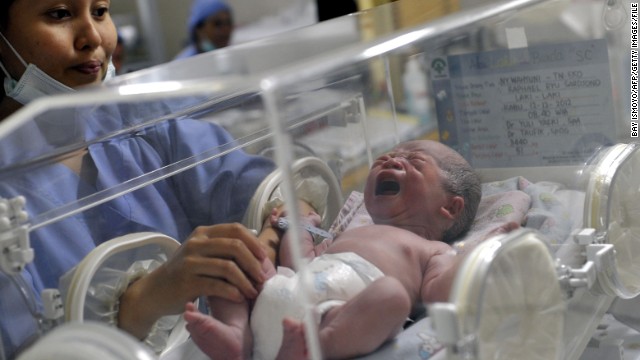
[ad_1]
The research revealed that C-sections remain more common in certain parts of the world.
In 2015, its use was up to 10 times more frequent in Latin American and Caribbean regions, where it was used in 44.3% of births, than in West and Central African regions, where it was used in only 4.1% of births, according to the study.
In the United States, 32% of births were by C-section in 2015, an increase from 23% in 2000, the data showed, and in the United Kingdom, 26.2% of births were by C-section in 2015, up from 19.7% in 2000.
“It is crucial that women who need caesarean sections are able to access this potentially life-saving procedure, but equally unnecessary procedures should be avoided, so that the lives and well-being of women and their babies are not put at risk,” Dr. Ana Pilar Betran, medical officer at WHO Department of Reproductive Health and Research, said in the organization’s announcement of the new guidelines.
Where C-section rates are highest and lowest
On the other hand, “the large increases in C-section use to levels well over 30% in many countries, often for non-medical indications, is of concern given the risks for both women and children,” he said. “It is important country ministries of health, the medical profession and civil society critically consider these statistics and ensure that overuse is minimized.”
The new study in The Lancet used data from WHO and the United Nations Children’s Fund to describe trends in live births across 169 countries between 2000 and 2015. The researchers stopped at 2015 because only a few countries had data points beyond that year.
Based on the latest data, the researchers found that the country with the lowest C-section rate, at 0.6% in 2010, was South Sudan and the country with the highest, at 58.1% in 2014, was the Dominican Republic.
Other countries where more than half of births were by C-section were Brazil, at 55.5% in 2015; Egypt, at 55.5% in 2014; Turkey, at 53.1% in 2015; and Venezuela, at 52.4% in 2013.
When the data was examined by region, the researchers found that C-section birth rates in 2015 were:
- 4.1% in West and Central Africa
- 6.2% in Eastern and Southern Africa
- 29.6% in the Middle East and North Africa
- 18.1% in South Asia
- 28.8% in East Asia and the Pacific
- 44.3% in Latin America and Caribbean
- 27.3% in Eastern Europe and Central Asia
- 32% in North America
- 26.9% in Western Europe
“The big differences in the use of C-section are a major finding,” Boerma said.
In 2015, “15 countries including Brazil, Egypt, Turkey and Mexico have C-section use over 40%, while the average for west and central Africa is only 4%,” he said.
“In developing countries, or low- and middle-income countries, wealthy women have more than five times higher C-section use than poor women. Part of this is because poor women more often deliver at home, but even if they reach a health facility, they are almost 2.5 times less likely to get C-section,” he said.
Countries with C-section use of 15% or more were more likely to have higher levels of socioeconomic development, women’s education, urbanization and density of physicians and lower fertility rates than countries with C-section use in less than 10% of births, according to the study.
In the US, where 32% of births were by C-section, there were also state-by-state differences.
Utah ranked lowest at 22.3%, followed by Alaska at 23%, Idaho at 23.9% and New Mexico at 24.8%, according to the CDC.
As for the new study, it had some limitations, including that the researchers were unable to obtain more recent data for all countries and that the data relied heavily on self-reported survey responses for births in low-income and middle-income countries. Self-reported data run the risk of bias.
“So there are several downsides of cesarean section, but we also have to see it as a lifesaving intervention and as something that is necessary in many cases,” he said.
“Certainly, the issue is that in some settings, we have too much, and in many settings — in African countries, for instance — we have too low, and the too low is even worse because although we are saying we have too many cesarean section rates, we still have to make sure there’s sufficient cesarean section rates in many of those African countries,” he said. “I think there’s danger in saying to ‘decrease, decrease, decrease,’ but we forget about those settings where we still don’t have enough cesarean sections. Both are very important.”
A call for help
A series of separate papers was published alongside the new study.
The other paper examined possible interventions to help reduce the use of unnecessary C-sections. The paper noted that various factors drive the rise in C-section use, including that some women may request C-section due to fears of labor or convenience and that some physicians may use C-section to avoid difficult deliveries or risk of litigation.
Some of the interventions described in the paper include having midwives working more closely with physicians, addressing women’s fears of labor pain or concerns with vaginal deliveries, and promoting prenatal care.
“Worldwide there is an alarming increase in caesarean section (CS) rates,” the paper said. “The medical profession on its own cannot reverse this trend. Joint actions with governmental bodies, the health care insurance industry, and women’s groups are urgently needed to stop unnecessary CSs and enable women and families to be confident of receiving the most appropriate obstetric care for their individual circumstances.”
Source link


